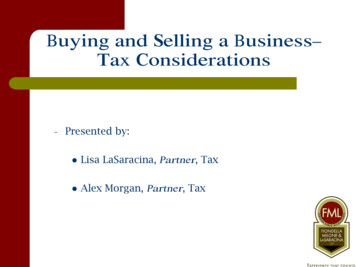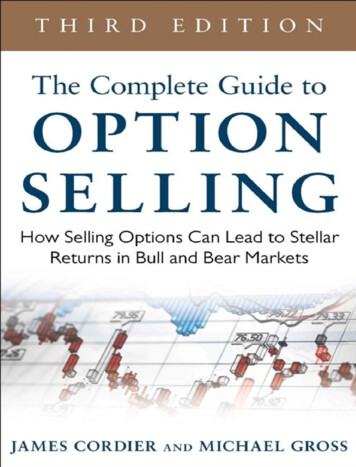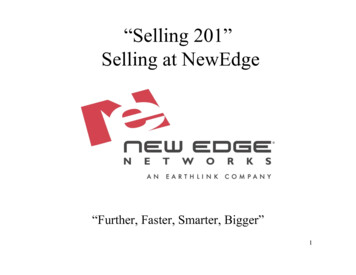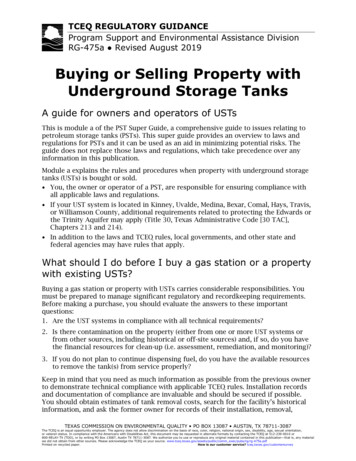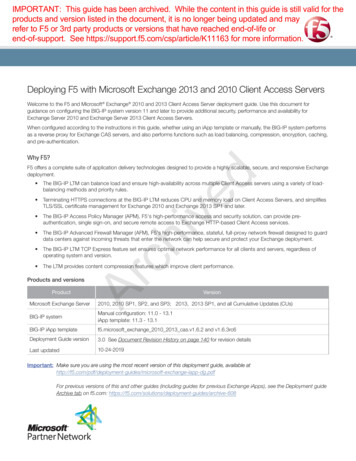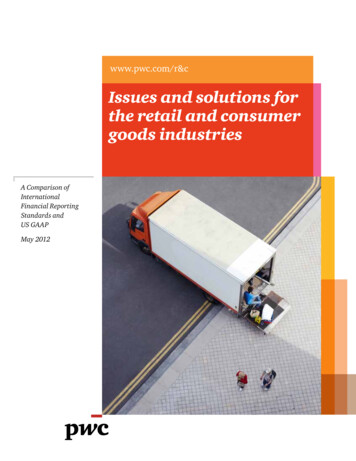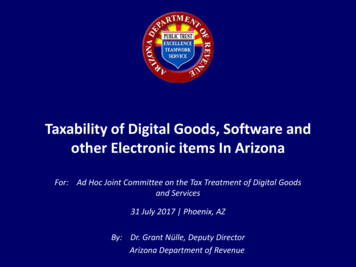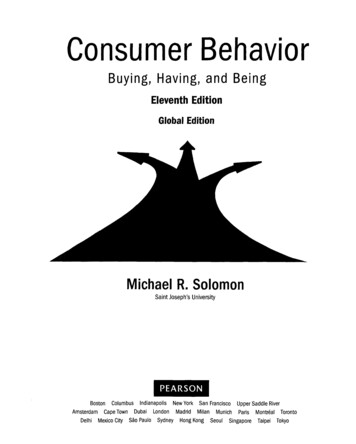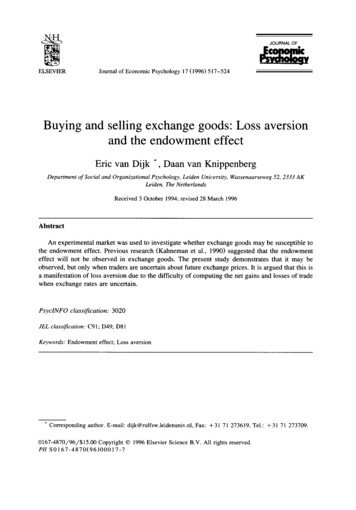
Transcription
JOURNAL OFNELSEVIERJournal of Economic Psychology 17 (1996) 517-524Buying and selling exchange goods: Loss aversionand the endowment effectEric van Dijk *, Daan van KnippenbergDepartment of Social and Organizational Psychology, Leiden Unit,ersit , Wassenaarseweg 52, 2333 AKLeiden, The NetherlandsReceived 3 October 1994; revised 28 March 1996AbstractAn experimental market was used to investigate whether exchange goods may be susceptible tothe endowment effect. Previous research (Kahneman et al., 1990) suggested that the endowmenteffect will not be observed in exchange goods. The present study demonstrates that it may beobserved, but only when traders are uncertain about future exchange prices. It is argued that this isa manifestation of loss aversion due to the difficulty of computing the net gains and losses of tradewhen exchange rates are uncertain.PsyclNFO classification." 3020JEL classification: C91 ; D49; D81Keywords: Endowment effect; Loss aversion* Corresponding author. E-mail: dijk@rulfsw.leidenuniv.nl, Fax: 31 71 273619, Tel.: 31 71 273709.0167-4870/96/ 15.00 Copyright 1996 Elsevier Science B.V. All rights reserved.Pll S 0 1 6 7 - 4 8 7 0 ( 9 6 ) 0 0 0 1 7 - 7
518E. van Dijk, D. can Knippenberg /Journal of Economic Psychology 17 (1996) 517-5241. IntroductionIn the analysis of the bargaining process between potential buyers and sellersof commodities, economic theory assumes that preferences are not affected byownership. Thus, when income effects and transaction costs are minimal, thewillingness to pay for a certain good should equal the willingness to accept. Incontrast with these assumptions, however, empirical research shows considerable differences between buying and selling prices of consumption goods (seee.g., Ortona and Scacciati, 1992: Tietz, 1992; Kahneman et al., 1990). Someauthors have claimed that these findings may be explained in economic terms.For example, as argued by Knez et al. (1985), strategic considerations mayinduce buyers to understate, and sellers to overstate their true values. In order toassess whether the observed disparity between buying and selling prices may bedue to something other than strategic pricing, one should investigate situationsin which buyers and sellers cannot influence the actual trading price with theirstated value, a condition we meet in the present study. Even in these circumstances, however, disparities between buying and selling prices have beendemonstrated (Kahneman et al., 1990).The finding that people demand more money as compensation for giving upan object than they are willing to pay in order to obtain the same object isreferred to as the 'endowment effect' (Thaler, 1980), and is generally interpretedas a manifestation of 'loss aversion', the generalization that losses are weightedmore heavily than gains (Kahneman and Tversky, 1979). A tendency for thedisutility of losing an object to exceed the utility of gaining the same objectwould indeed explain the disparity between selling and buying prices (see alsoKahneman et al., 1990; Thaler et al., 1994). This does not mean that theendowment effect will be observed in all goods of a positive value, however. AsKahneman (1992, p. 301) stated: "loss aversion does not affect all transactions.The critical distinction is between goods held for use and goods held forexchange." Kahneman distinguished three categories of exchange goods: (1)money held for spending: (2) goods held specifically for sale; and (3) goods thatare only valued because they can be traded ('bargaining chips'). Kahnemanconcluded that "Loss aversion plays little role in routine economic transactions,in which sellers and buyers trade goods for money, both of which were held forthat purpose" (Kahneman, 1992, p. 301).Why would exchange goods not be susceptible to the endowment effect?What seems crucial is that the value of exchange goods is mainly derived fromthe monetary value obtained by exchange. According to Kahneman (1992), in
E. ran Dijk, D. t'an Knippenberg / Journal of Economic Psychology 17 (1996) 517-524519such situations traders may not consider selling the good as a loss (for whichthey should be compensated) and buying a good as a gain (for which they arewilling to pay). Instead, they may compute the n e t gains and losses associatedwith trading the exchange good (and thus experience no loss aversion). Researchon the buying and selling prices of bargaining chips seems to corroborate thisreasoning. In two market experiments, Kahneman et al. (1990, Experiments 1and 5) investigated buying and selling prices for 'induced-value tokens' (i.e.,bargaining chips that could be exchanged for a certain value). CorroboratingKahneman's conclusion, buying and selling prices did not differ significantly. Itshould be noted, however, that in these experiments computing the net gain orloss was relatively simple. The exchange value of the bargaining chip was fixed:buyers and sellers knew beforehand the exchange value of the bargaining chip.Indeed, under such conditions it seems very unlikely that for example sellersbeing offered 2.05 for a bargaining chip with an exchange value of 2.00 willexperience loss aversion. They may quite readily realize that trading the chipwill provide them a net gain of .05. If transaction costs are minimal, sellersmay be willing to accept any price that equals or exceeds the fixed exchangeprice, whereas buyers may be willing to pay any price equal to or lower than theexchange price.But what if computing the net gain is not that simple? What if exchangeprices are not fixed, and traders are not certain how much money they willeventually receive for giving up their exchange good? Will they still evaluatetrades in terms of net gains or losses? In essence, selling a good with anuncertain exchange value can be viewed as trading a risky prospect for cash. Dopeople integrate risky prospects and cash payments in order to compute netgains or losses? Research on Prospect theory and risky decision making suggeststhey do not: when comparing sure outcomes (e.g., cash) with risky prospectspeople do experience loss aversion (Kahneman and Tversky, 1979, 1984). Thiscould mean that an endowment effect in buying and selling prices of exchangegoods c a n be expected when buyers and sellers are uncertain about futureexchange rates. Under these conditions people may experience loss aversion dueto the fact that it is more difficult or even impossible to compute net gains oftrading cash for uncertain exchange values (see also Kahneman et al., 1990).In order to investigate the effect of uncertainty of exchange rates on prices,we designed an experimental market in which we compared buying and sellingprices of bargaining chips with a fixed value with buying and selling prices ofbargaining chips with an uncertain value. In agreement with the findings ofKahneman et al. (1990) we expected no endowment effect in the case of a fixedmonetary value. Reasoning that uncertainty may prevent people from evaluating
520E. van Dijk, D. van Knippenberg / J o u r n a l of Economic Psychology 17 (1996) 517-524a trade in terms of net gains/losses, we did expect an endowment effect in thecase of an uncertain exchange value.2. Method2.1. Design and participantsSixty-six students (35 females; 31 males; mean age: 21 years) of LeidenUniversity participated in the experiment. Position (buyer vs. seller) and Uncertainty (fixed exchange value vs. uncertain exchange value) were manipulated ina 2 2 factorial design. Participants were randomly assigned to conditions, andpaid for their participation.2.2. ProcedureThe participants were invited to the laboratory in groups of up to eightpeople. Upon arrival, half of the participants received a bargaining chip. Thebargaining chips were said to represent money since they could be exchangedfor money at the end of the experiment. In the Fixed Exchange Value conditions, participants learned they could exchange the chip with the experimenterfor Dfl. 3.50 (1 Dutch Guilder .55 US). In the Uncertain Exchange Valueconditions, participants learned they could exchange the chip for an amount ofmoney between Dfl. 1.75 and Dfl. 5.25, depending on a chance procedure.Before exchanging the bargaining chip for money with the experimenter,however, participants could trade the bargaining chips among themselves:participants owning a chip (the Sellers) could sell this chip to participants notowning a chip (the Buyers). The procedure for indicating buying and sellingprices resembled the procedure used by Kahneman et al. (1990). On a separateform, prices were listed from Dfl. 0.25 to Dfl. 6.75 (with Dfl. 0.25 intervals).Sellers were requested to indicate for each price whether or not they would sellat that price. Buyers indicated for each price whether or not they would buy atthat price. The experimenter would randomly select a price on this form, thusestablishing the 'market price' for the chip. This procedure was intended toprevent participants from misstating their true values. It was stressed that if theyhad indicated that they were willing to buy/sell at this randomly selected'market price', they had to stick to their stated intention. With this procedure wealso attempted to diminish the possible effect of demand characteristics, whichmay affect choice behavior in experimental markets. After the experimenter
E. can Dijk. D. van Knippenberg / Journal of Economic Psychology 17 (1996) 517-524521collected the forms, participants estimated the value of the bargaining chip. Atthis point the experiment was ended. Participants were debriefed and allreceived Dfl. 5.00. All participants agreed to this procedure.3. Results3.1. OffersA 2 X 2 ANOVA on the offers (i.e., the selling price of the sellers and thebuying price of the buyers) revealed a Position main effect ( F ( 1 , 6 2 ) 12.8,p 0.001), indicating an endowment effect: The selling price of the sellers(mean Dfl. 3.76) exceeded the buying price of the buyers (mean Dfl. 3.05).As predicted, this main effect was qualified by a significant Position XUncertainty interaction (F(1,62) 4.1, p 0.05). Corroborating the findings ofKahneman et al. (1990), no significant endowment effect was observed whenthe value of the exchange good was fixed ( F ( 1 , 6 2 ) 1.2, p 0.3; overallmean Dfl. 3.40; mean for sellers Dfl. 3.56; mean for buyers Dfl. 3.25). Inagreement with our hypothesis, in the case of an uncertain exchange rate,however, the selling price (mean Dfl. 3.97) significantly exceeded the buyingprice (mean Dfl. 2.87; F(1,62) 15.7, p 0.0001). These results indicatethat exchange goods may, like consumption goods, be susceptible to theendowment effect, provided that exchange rates are uncertain.3.2. Expected exchange valueResearch in experimental markets suggests that value judgments and pricesmay be affected by uncertainty (for an excellent overview on this subject seeCamerer, 1992). In order to assess whether estimates of the exchange value wereaffected by ownership a n d / o r uncertainty, we asked participants to indicate themonetary value they expected to receive for the bargaining chip (i.e., the valuefor which it could eventually be exchanged with the experimenter). Not surprisingly, in the fixed value conditions, both buyers and sellers (correctly) estimatedthe exchange value to be Dfl. 3.50. Of course we were more interested in theestimates of buyers and sellers in the case of the uncertain exchange value. Inthe Uncertain Exchange Value conditions buyers' and sellers' estimates did notsignificantly differ from Dfl. 3.50 (mean for buyers Dfl. 3.34; t ( 1 6 ) 0.9,p 0.4; mean for sellers Dfl. 3.27; t(15) 1.5, p 0.2). More interestingly,these results indicate that even in these Uncertain Exchange Value conditionsbuyers and sellers did not differ in their estimates (t(31) 0.3, p 0.8).
522E. L'an Dijk, D. t,an Knippenberg / Journal of Economic Psychology 17 (1996) 517-524Thus, uncertainty of exchange rates did affect buying and selling prices (i.e.,uncertain exchange rates resulted in an endowment effect), but did not affect thevalue estimates of buyers and sellers. This is in line with the suggestion that theendowment effect is primarily the result of loss aversion: sellers did not expect ahigher exchange value than buyers, they just demanded more money for givingit up than buyers were willing to pay.4. ConclusionsTaken together, the results of the present study confirm the proposition (cf.Thaler, 1980; Thaler et al., 1994; Kahneman, 1992; Kahneman et al., 1990) thatthe endowment effect is a result of loss aversion. While corroborating thisproposition, the data do qualify Kahneman's (1992) conclusion that exchangegoods are not susceptible to the endowment effect. Our interpretation of the datais that an endowment effect may be observed in exchange goods when exchangerates are uncertain, because people are less likely or able to compute the netgains (cf. Kahneman and Tversky, 1984).One other thing that uncertainty may do is elicit a motivation to avoid regret.Could this explain the results of our present study? One of the basic assumptionsof the Loomes and Sugden (1982) Regret theory is that people may anticipatefeelings of regret. This notion on its own falls short of explaining the endowment effect, however. Anticipation of regret does not necessarily imply anunwillingness to buy or sell. People may also experience regret after not buyingor not selling. For example, in our experiment people may eventually regretbuying a chip for Dfl. 3.50 when the exchange rate turns out to be only Dfl.1.75. They may also regret n o t buying a chip for Dfl. 3.50 when the exchangerate turns out to be Dfl. 5.25. Similarly, people may not only regret selling achip for Dfl. 3.50 when the exchange rate turns out to be Dfl. 5.25, they mayalso regret n o t selling a chip for Dfl. 3.50 when the exchange rate is Dfl. 1.75.It is also appropriate to note that we do not claim that all disparities betweenbuying and selling prices are necessarily the result of loss aversion. Beggan(1992) argued that people may overvalue objects they own in order to maintain apositive self-image. In agreement with this interpretation, he demonstrated thatin many situations ownership may produce greater liking for an owned object. Ina similar vein, Ortona and Scacciati (1992) argued that the endowment effectmay be related to an 'instinctive bias' due to ownership. These interpretationswould imply a general overvaluation of objects owned, whereas we did notobserve an endowment effect in the case of fixed exchange rates. General
E. 'an Dijk, D. t'an Knippenberg / J o u r n a l of Economic Psychology 17 (1996) 517-524523overvaluation of objects owned may be more prevalent in the case of consumergoods than in the case of exchange goods, however. Beggan's (1992) analysis ofthe mere ownership effect presupposes that "possessions are objects associatedwith the self" (Beggan, 1992, p. 229). In our experiment (i.e., a study onexchange goods) participants may not have experienced such an associationbecause they realized that at the end of the experiment the bargaining chipswould be exchanged for money.Although the main focus of our study was on the question whether anendowment effect may be observed in the trade of exchange goods, it may beworthwhile to elaborate on the possible implications for research on consumption goods. The bulk of the research on the endowment effect has been onconsumption goods (e.g., mugs, chocolate bars) in situations where it may bedifficult to compute the net gains and losses of trade. If someone wants to buyyour chocolate bar you may perceive giving up the chocolate bar as a loss. Butwhat would happen if someone offered you one and a half chocolate bars foryour chocolate bar? In this situation it is easy to compute the net gains of trade(you would gain half a chocolate bar), and you would probably not besusceptible to the endowment effect. This tentative example suggests that topredict whether sellers and buyers will experience loss aversion, research shouldnot only focus on what is being traded (e.g., exchange goods or consumptiongoods). Instead, research should also focus on what is being traded for what. Itmay be worthwhile to relate these insights to the characteristics approach ofLancaster (1971). In his theory of consumer demand Lancaster viewed goods asbundles of characteristics. One of the propositions of this theory is that goodswill be more substitutable the more characteristics they have in common. In asimilar vein, we suggest that people will be less subject to the endowment effectthe more characteristics the objects traded have in common; in such situations itmay be more easy to compute the net gains and losses of trade. It seemsappropriate to investigate the relation between substitutability and the endowment effect in future research by comparing the willingness to trade for goodsvarying in the number of common characteristics.ReferencesBeggan, J.K. 1992. On the social nature of nonsocial perception: The mere ownership effect. Journal ofPersonality and Social Psychology 62, 229-237.Camerer, C., 1992. The rationality of prices and volume in experimental markets. Organizational Behavior andHuman Decision Processes 51,237-272.Kahneman, D., 1992. Reference points, anchors, norms, and mixed feelings. Organizational Behavior andHuman Decision Processes 51, 296-312.
524E. van Dijk, D. L,an Knippenberg / Journal of Economic Psychology 17 (1996) 517-524Kahneman, D., J.L. Knetsch and R.H. Thaler, 1990. Experimental tests of the endowment effect and theCoase-theorem. Journal of Political Economy 98, 1325-1348.Kahneman, D. and A. Tversky, 1979. Prospect theory: An analysis of decision under risk. Econometrica 47,263-291.Kahneman, D. and A. Tversky, 1984. Choices, values, and frames. American Psychologist 39, 341-350.Knez, M, V.L. Smith and A.W. Williams, 1985. Individual rationality, market rationality, and valueestimation. American Economic Review 75, 397-402.Lancaster, K. J., 1971. Consumer demand: A new approach. New York: Columbia University Press.Loomes, G. and R. Sugden, 1982. Regret theory: An alternative theory of rational choice under uncertainty.Economic Journal 92, 805-824.Ortona, G. and F. Scacciati, 1992. New experiments on the endowment effect. Journal of EconomicPsychology 13, 277-296.Thaler, R., 1980. Toward a positive theory of consumer choice. Journal of Economic Behavior andOrganization 1, 39-60.Thaler, R., D. Kahneman and J.L. Knetsch, 1994. 'The endowment effect, loss aversion, and status quo bias'.In: R. Thaler (Ed.), The Winners's Curse: Paradoxes and Anomalies of Economic Life (pp. 63-78).Princeton, NJ: Princeton University Press.Tietz, R., 1992. "An endowment effect in market experiments?" In: S.E.G. Lea, P. Webley, and B.M. Young(Eds.), New Directions in Economic Psychology: Theory, Experiment and Application (pp. 99-121).Aldershot: Elgar.
E. ran Dijk, D. t'an Knippenberg / Journal of Economic Psychology 17 (1996) 517-524 519 such situations traders may not consider selling the good as a loss (for which they should be compensated) and buy
